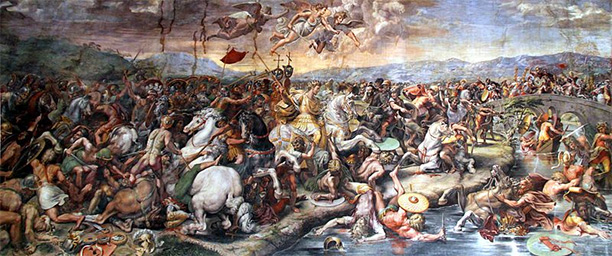The Battle of the Milvian Bridge
Constantine won a great victory on October 28th, 312.
 Roman politics after the Emperor Diocletian abdicated in AD 305 was confusingly complicated as emperors and deputy emperors of the West and of the East contended for power. Among them was Flavius Valerius Constantinus, known to history as Constantine the Great. Acclaimed as emperor by his troops in York in AD 306, he was appointed Caesar or deputy emperor of the West by Diocletian’s successor, Galerius. Constantine was in charge of Britain and Gaul, but his brother-in-law Maxentius waged war against Galerius and seized Italy and Rome itself.
Roman politics after the Emperor Diocletian abdicated in AD 305 was confusingly complicated as emperors and deputy emperors of the West and of the East contended for power. Among them was Flavius Valerius Constantinus, known to history as Constantine the Great. Acclaimed as emperor by his troops in York in AD 306, he was appointed Caesar or deputy emperor of the West by Diocletian’s successor, Galerius. Constantine was in charge of Britain and Gaul, but his brother-in-law Maxentius waged war against Galerius and seized Italy and Rome itself.
Galerius died in AD 311 and early the next year Constantine invaded Italy, won battles at Turin and Verona and marched on Rome. Maxentius came out to fight and was destroyed at the Milvian Bridge, which carried the Via Flaminia over the Tiber into the city. The battle was one of a succession of victories that in AD 324 made Constantine master of the entire Roman Empire, but it is most famous for its link with his conversion to Christianity, which would prove to be one of the most important events in world history.
The story, or a story, of what happened was told by Eusebius of Caesarea, a Christian biblical scholar and historian who wrote the first biography of Constantine soon after the emperor’s death. He knew Constantine well and said he had the story from the emperor himself. Constantine was a pagan monotheist, a devotee of the sun god Sol Invictus, the unconquered sun. However before the Milvian Bridge battle he and his army saw a cross of light in the sky above the sun with words in Greek that are generally translated into Latin as In hoc signo vinces (‘In this sign conquer’). That night Constantine had a dream in which Christ told him he should use the sign of the cross against his enemies. He was so impressed that he had the Christian symbol marked on his soldiers’ shields and when the Milvian Bridge battle gave him an overwhelming victory he attributed it to the god of the Christians.
This story was generally accepted for centuries, but today’s historians who are not believers in prophetic visions and dreams have serious doubts about it. The earliest account of the battle, dating from AD 313, mentions nothing about a vision or a dream. It says that Maxentius drew up his army on the bank of the Tiber. He had cut the bridge itself, but in case of defeat he could retreat to Rome across a temporary bridge made of boats. When Constantine’s cavalry charged, however, Maxentius’s men were driven in flight across the bridge of boats, which collapsed under them, and many were drowned, including Maxentius himself. His head was cut off and carried into the city on a spear by the triumphant Constantine and his men.
According to another early account, written within two years of the battle by the Christian author Lactantius, who had been at Constantine’s court for some time, the emperor had a dream in which he was told to mark ‘the heavenly sign of God’ on his soldiers’ shields. He did as instructed, had the sign, whatever exactly it was, inscribed on the shields and attributed his victory against odds to the god of the Christians. In AD 315 the Senate dedicated a triumphal arch in Rome to Constantine (it may have been built originally for Maxentius), with an inscription praising him because ‘with divine instigation’ he and his army had won the victory. It tactfully refrained from saying which god had provided the ‘instigation’ and citizens could credit it to Sol Invictus or the Christian deity or whichever god they chose.
What is not in doubt is that Constantine became a believing Christian who vigorously promoted Christianity without trying to force it down pagan throats. Diocletian and Galerius had persecuted the Christians savagely, but in AD 311 Galerius had granted them freedom of worship. In AD 313 Constantine’s Edict of Milan proclaimed that ‘no one whatsoever should be denied the opportunity to give his heart to the observance of the Christian religion’. He appointed Christians to high office and gave Christian priests the same privileges as pagan ones. By AD 323 the birthday of Sol Invictus on December 25th had become the birthday of Christ. The emperor strove to iron out theological disagreements among Christians and in AD 325 he personally attended the Council of Nicaea, which formulated the doctrine of the Trinity. He also built magnificent churches, including Santa Sophia in his capital city of Byzantium, renamed Constantinople. When he died in AD 337 Christianity was well on its way to becoming the state religion of the Roman Empire and Constantine considered himself the 13th apostle of Jesus Christ.




